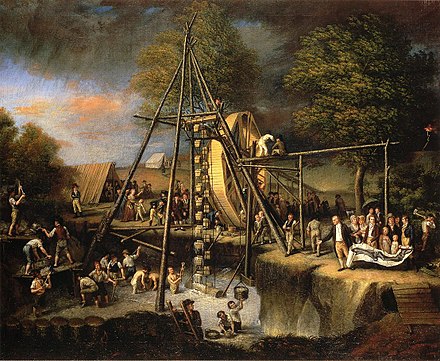As patriarch of an artistic dynasty, Peale named many of his fourteen children after famous artists, his sons Raphaelle, Rembrandt, Rubens and Titian Ramsay, became artists. Rubens' daughter Mary Jane Peale (1827-1902) became an artist, her oil painting Grapes and Peaches is in the Philadelphia Museum of Art. One of the last artists in the family dynasty, she taught her father to paint after his retirement.
Four of Charles Willson's nieces (James' daughters) became professional artists: Maria Claypoole Peale, Anna Claypoole Peale, Margaretta Angelica Peale, and Sarah Miriam Peale. Sarah was the first female artist in America to make her living as a professional artist, and she taught her niece, Mary Jane.
Charles Willson Peale created silhouettes with the physiognotrace, a machine used to record profiles. A young slave in the Peale household, John Williams, grew up with the Peale children. He was taught art-related skills which enabled him to work at the Peale Museum, and later, as a freedman, he continued to work at the museum, making a good living primarily as a silhouette artist.
Peale was also a scientist, inventor, politician and naturalist and had expertise in diverse fields, including carpentry, dentistry, optometry, shoemaking, and taxidermy. He patented a fireplace, porcelain false teeth, and a unique type of wooden bridge. He co-invented a device called the polygraph, which used the principle of the pantograph to create a duplicate copy of a handwritten letter. Jefferson had several, and called it "the finest invention of the present age."

Jefferson's Polygraph (Reproduction)
(Image by (From Wikimedia) National Portrait Gallery, Smithsonian Institution, Author: National Portrait Gallery, Smithsonian Institution) Details Source DMCA
Peale also invented a rudimentary motion picture technique; and wrote papers on engineering, hygiene, and other subjects.
Peale co-founded the Pennsylvania Academy of Art in 1805, the first and oldest art museum and art school in America, where he exhibited his art as well as the skeleton the first mastodon found in America, which he excavated. He pioneered the concept of re-assembling large skeletal specimens in three dimensions.

The Exhumation of the Mastadon by Charles Willson Peale
(Image by (Not Known) Wikipedia (commons.wikimedia.org), Author: Author Not Given) Details Source DMCA
One of his last works was his full-length self-portrait, The Artist in his Museum (1822; col. The Pennsylvania Academy of the Fine Arts)

C W Peale - The Artist in His Museum.
(Image by (Not Known) Wikipedia (commons.wikimedia.org), Author: Author Not Given) Details Source DMCA
Peale painted nearly 60 portraits of George Washington as well as portraits of Benjamin Franklin, John Hancock, the Marquis de Lafayette, Thomas Jefferson and Alexander Hamilton.
In January 2005, Peale's full-length portrait of Washington at Princeton sold for $21.3 million, setting a record for the highest price paid for an American portrait. (The original painting was dated 1779. Upon demand, Peale later made several copies of this painting.)

George Washington at the Battle of Princeton by Charles Willson Peale (Created: 1781 (this copy); 1779 (original)_
(Image by (Not Known) Wikipedia (commons.wikimedia.org), Author: Author Not Given) Details Source DMCA
The Pillared Temple Hall

Pillared Temple Hall (Madanagopalaswamy Temple, Madurai, T. | Flickr
(Image by flickr.com) Details DMCA
Walking through the Pillared Temple Hall exhibit is a magical and other-worldly experience. The more than sixty carved granite elements in it were found, piled as rubble, within the compound of a 16th C. Krishna temple by Philadelphian Adeline Pepper Gibson during her visit to the south of India in 1912. The temple hall was originally part of the Madana Gopala Swamy temple complex, most of which still stands in Maduri in southern India.
(Note: You can view every article as one long page if you sign up as an Advocate Member, or higher).





